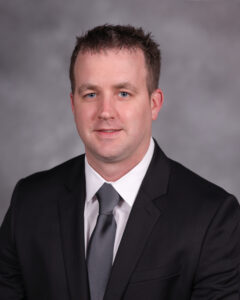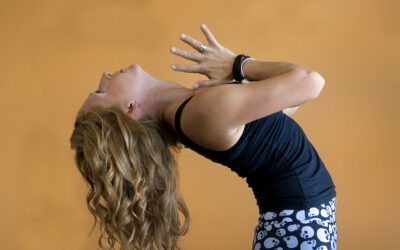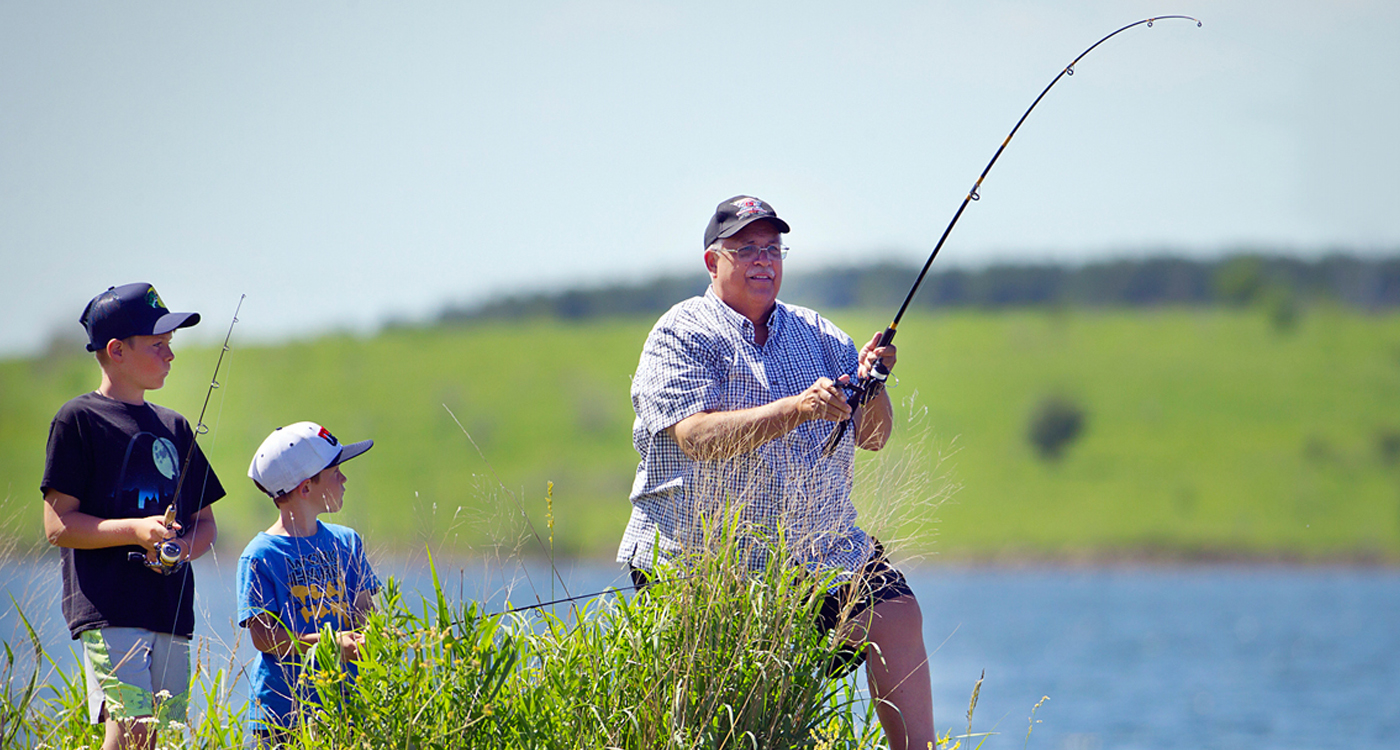After his rotator cuff surgery, Mike Cluff of Davenport goes for the big catch – fishing with his grandchildren on summer days.

Mike and his grandsons take off on a Monday afternoon to go hit their favorite fishing hole.
“I’m living my best life,” affirms, Mike Cluff, 66, a retired postal carrier and full-time grandfather. The avid fisherman and pickleball player hasn’t looked back since his retirement, enjoying his days with family, friends and wife, Gretchen.
“My injury came after I retired,” recalls Mike. “Gretchen and I were playing pickleball, and just out of the clear blue, I reached with my right arm for a wide forehand shot, and the minute I made contact with the ball, I felt something snap! My arm just dropped. I knew I had done something bad.
“I’m one of those guys who won’t go to the doctor unless blood is gushing out or pieces are falling off,” Mike laughs. “I really thought I had just pulled a muscle. But as the weeks went by, I couldn’t do anything. I couldn’t function or sleep. Everything I did, hurt. I couldn’t play ball with the grandkids or raise my arm above my head.”
Mike says during a painful Wisconsin trip, he was sidelined from playing bocce ball with friends. “I couldn’t throw the ball, it hurt so badly. People hounded me to get it taken care of, so I finally made the appointment at ORA.”
Minimally invasive rotator cuff surgery meant Mike was back casting as soon as possible

Dr. Ryan Dunlay, ORA Orthopedics
Sports Medicine Physician, Dr. Ryan Dunlay, ordered an MRI that revealed the source of the pain. “Mike had a rotator cuff tear. The rotator cuff is a group of tendons that stabilize and attach to the ball of your shoulder joint. A tear can involve one or multiple tendons.
“In particular, Mike had a full tear of one of his tendons. It’s a fairly common injury, especially in older and active adults. Our tendons inherently weaken with age as they begin to lack the blood supply that keeps them strong.”
Dr. Dunlay recommended outpatient rotator cuff surgery. “I repair the tears by using an arthroscope attached with a small camera to make very tiny incisions. We also use bio-absorbable anchors to attach the tendon to the bone until it heals, then the anchor slowly dissolves into the body. Our goal is that the surgery has the smallest possible impact on the body.
“Surgical technology continues to evolve in amazing ways. Old anchors used to be made of metal and would stay in the body permanently, which made some patients uncomfortable. Today these new suture anchors are actually absorbed into the body as it heals.
Following Mike’s surgery, he was home the same day with minimal scars and a prognosis for a full recovery. “I was in a sling for a little over a month, my physical therapy was terrific, and I never had any pain.
“I told Dr. Dunlay he was a miracle worker. He is great — very calm, laid back and straightforward.”

Mike’s back doing the thing he loves with the people who matter most to him … he’s living his best life.
“Mike is a great example of healthy aging,” said Dr. Dunlay. “I always tell my older patients that ‘motion is lotion’ and to keep moving! Injuries happen and can really affect activities with family and friends. The more active and socially connected people are, the greater their quality of life as well as their ability to heal from injuries.
“Our goal at ORA Orthopedics is to help our patients resume the activities they love to do. When we fix a body’s biomechanics, it has a positive impact on the rest of their lives.”
Four months after Mike’s surgery, he is back up to full speed, playing pickleball three times a week, and fishing with his grandchildren.
“Life is good and both Gretchen and I truly believe we are living our best lives.”
Keep reeling in the memories, Mike.

Mike and his grandsons take off on a Monday afternoon to go hit their favorite fishing hole.
“I’m living my best life,” affirms, Mike Cluff, 66, a retired postal carrier and full-time grandfather. The avid fisherman and pickleball player hasn’t looked back since his retirement, enjoying his days with family, friends and wife, Gretchen.
“My injury came after I retired,” recalls Mike. “Gretchen and I were playing pickleball, and just out of the clear blue, I reached with my right arm for a wide forehand shot, and the minute I made contact with the ball, I felt something snap! My arm just dropped. I knew I had done something bad.
“I’m one of those guys who won’t go to the doctor unless blood is gushing out or pieces are falling off,” Mike laughs. “I really thought I had just pulled a muscle. But as the weeks went by, I couldn’t do anything. I couldn’t function or sleep. Everything I did, hurt. I couldn’t play ball with the grandkids or raise my arm above my head.”
Mike says during a painful Wisconsin trip, he was sidelined from playing bocce ball with friends. “I couldn’t throw the ball, it hurt so badly. People hounded me to get it taken care of, so I finally made the appointment at ORA.”
Minimally invasive rotator cuff surgery meant Mike was back casting as soon as possible

Dr. Ryan Dunlay, ORA Orthopedics
Sports Medicine Physician, Dr. Ryan Dunlay, ordered an MRI that revealed the source of the pain. “Mike had a rotator cuff tear. The rotator cuff is a group of tendons that stabilize and attach to the ball of your shoulder joint. A tear can involve one or multiple tendons.
“In particular, Mike had a full tear of one of his tendons. It’s a fairly common injury, especially in older and active adults. Our tendons inherently weaken with age as they begin to lack the blood supply that keeps them strong.”
Dr. Dunlay recommended outpatient rotator cuff surgery. “I repair the tears by using an arthroscope attached with a small camera to make very tiny incisions. We also use bio-absorbable anchors to attach the tendon to the bone until it heals, then the anchor slowly dissolves into the body. Our goal is that the surgery has the smallest possible impact on the body.
“Surgical technology continues to evolve in amazing ways. Old anchors used to be made of metal and would stay in the body permanently, which made some patients uncomfortable. Today these new suture anchors are actually absorbed into the body as it heals.
Following Mike’s surgery, he was home the same day with minimal scars and a prognosis for a full recovery. “I was in a sling for a little over a month, my physical therapy was terrific, and I never had any pain.
“I told Dr. Dunlay he was a miracle worker. He is great — very calm, laid back and straightforward.”

Mike’s back doing the thing he loves with the people who matter most to him … he’s living his best life.
“Mike is a great example of healthy aging,” said Dr. Dunlay. “I always tell my older patients that ‘motion is lotion’ and to keep moving! Injuries happen and can really affect activities with family and friends. The more active and socially connected people are, the greater their quality of life as well as their ability to heal from injuries.
“Our goal at ORA Orthopedics is to help our patients resume the activities they love to do. When we fix a body’s biomechanics, it has a positive impact on the rest of their lives.”
Four months after Mike’s surgery, he is back up to full speed, playing pickleball three times a week, and fishing with his grandchildren.
“Life is good and both Gretchen and I truly believe we are living our best lives.”
Keep reeling in the memories, Mike.





Recent Comments